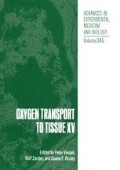Abstract
Since tobacco smoke contains 1.5–4.5% carbon monoxide cigarette smoking induces a rise in the blood CO-hemoglobin concentration with a subsequent decrease in the O2-capacity and a simultaneous increase in the hemoglobin O2-affinity. Both effects cause a restriction of respiratory gas exchange. Aim of the present study was to investigate the influence of tobacco smoking during pregnancy on the O2-affinity and the CO2-binding of maternal blood. Using the derived results, a model describing the blood O2 dissociation curve for the conditions of increased concentrations of CO-hemoglobin and of 2,3-DPG was developed. In addition, maternal to fetal oxygen transfer at elevated CO-hemoglobin fractions in maternal blood was analysed.
Access this chapter
Tax calculation will be finalised at checkout
Purchases are for personal use only
Preview
Unable to display preview. Download preview PDF.
References
Adair, G. S. (1925): The hemoglobin system. VI. The oxygen dissociation curve of hemoglobin. J. Biol. Chem. 63, 529–545.
Bauer, Ch., M. Ludwig, I. Ludwig, and H. Bartels (1969): Factors governing the oxygen affinity of human adult and fetal blood. Respir. Physiol. 7, 271–277.
Braumann, K.-M., D. Böning, and F. Trost (1982): Bohr effect and slope of the oxygen dissociation curve after physical training. J. Appl. Physiol. 52, 1524–1529.
Forster, R.E. (1970): Carbon monoxide and the partial pressure of oxygen in tissue. Ann. NY Acad. Sci. 174: 233–241.
Grote, J. (1986): Oxygen affinity and erythrocyte 2,3-diphosphoglycerate in blood during anemia of pregnancy. In: Funktionsanalyse biologischer Systeme 16:33–39.
Haldane, J.B.S. (1912/13): The dissociation of oxyhaemoglobin in human blood during partial CO poisoning. J. Physiol., London 45: XXII-XXIV.
Hlastala, M.P., H.P. McKenna, R.L. Franada, and J.C. Detter (1976): Influence of carbon monoxide on hemoglobin-oxygen binding. J. Appl. Physiol. 41, 893–899.
Lucius, H., H. Gahlenbeck, H.-O. Kleine, H. Fabel, and H. Bartels (1970): Respiratory functions, buffer system, and electrolyte concentrations of blood during human pregnancy. Respir. Physiol. 9, 311–317.
Niesel, W., und G. Thews (1961): Ein neues Verfahren zur schnellen und genauen Aufnahme der Sauerstoffbindungskurve des Blutes und konzentrierter Hämoproteinlösungen. Pflügers Arch. 273, 380–395.
Okada, Y., I. Tyuma, Y. Ueda, and T. Sugimoto (1976): Effect of carbon monoxide on equilibrium between oxygen and hemoglobin. Am. J. Physiol. 230, 471–475.
Reeves, R.B. (1980): A rapid micro method for obtaining oxygen equilibrium curves on whole blood. Respir. Physiol. 42, 299–315.
Severinghaus, J.W. (1979): Simple, accurate equations for human blood OZ dissociation computation. J. Appl. Physiol. 46, 599–602.
Zander, R. (1986): COHb-Konzentrationen im Blut bei Rauchern und Nichtrauchern. In: Der Sauerstoff-Status des arteriellen Blutes, Zander, R., Mertzlufft, F.O. (eds.), pp. 183–186, Basel: Karger.
Zwart, A., G. Kwant, B. Oeseburg, and W.G. Zijlstra (1984): Human whole-blood oxygen affinity: effect of carbon monoxide. J. Appl. Physiol. 57, 14–20.
Author information
Authors and Affiliations
Editor information
Editors and Affiliations
Rights and permissions
Copyright information
© 1994 Springer Science+Business Media New York
About this chapter
Cite this chapter
Grote, J., Dall, P., Oltmanns, K., Stolp, W. (1994). The Effect of Increased Blood Carbon Monoxide Levels on the Hemoglobin Oxygen Affinity During Pregnancy. In: Vaupel, P., Zander, R., Bruley, D.F. (eds) Oxygen Transport to Tissue XV. Advances in Experimental Medicine and Biology, vol 345. Springer, Boston, MA. https://doi.org/10.1007/978-1-4615-2468-7_19
Download citation
DOI: https://doi.org/10.1007/978-1-4615-2468-7_19
Publisher Name: Springer, Boston, MA
Print ISBN: 978-1-4613-6051-3
Online ISBN: 978-1-4615-2468-7
eBook Packages: Springer Book Archive

